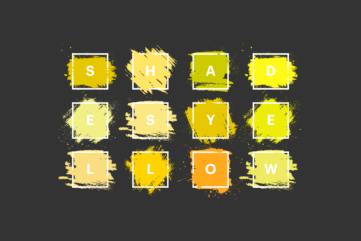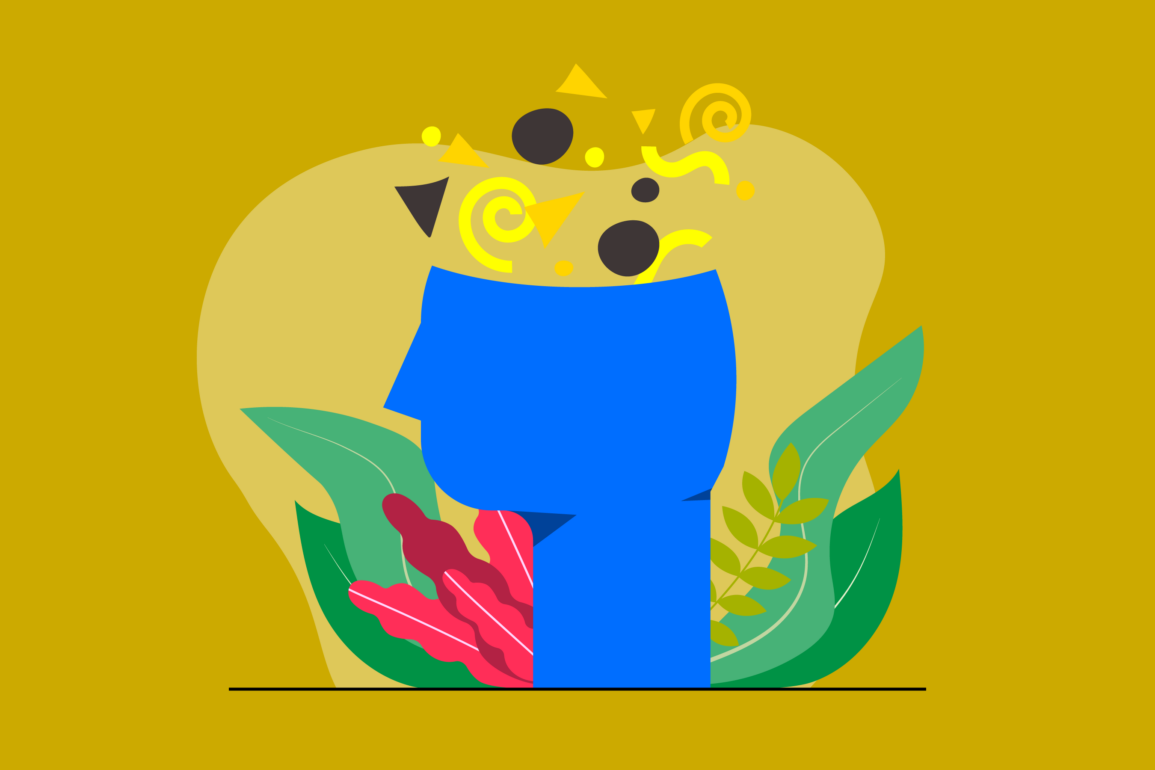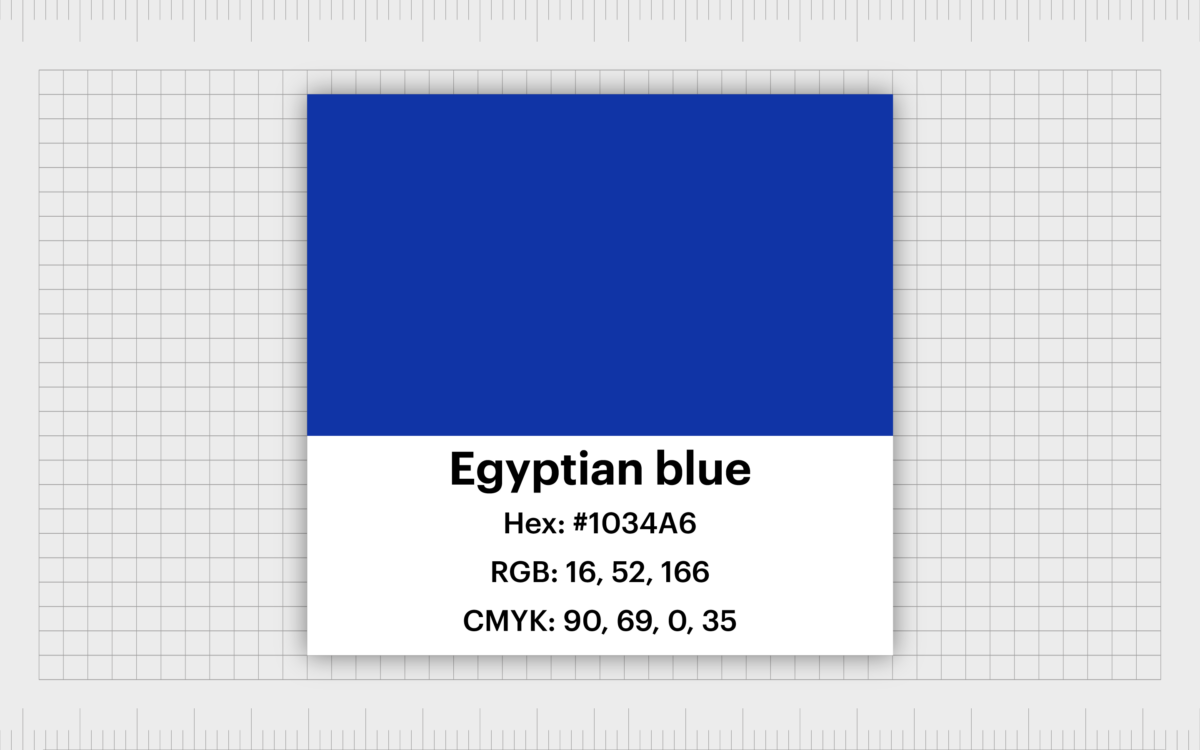Shades of blue: The many different kinds of blue
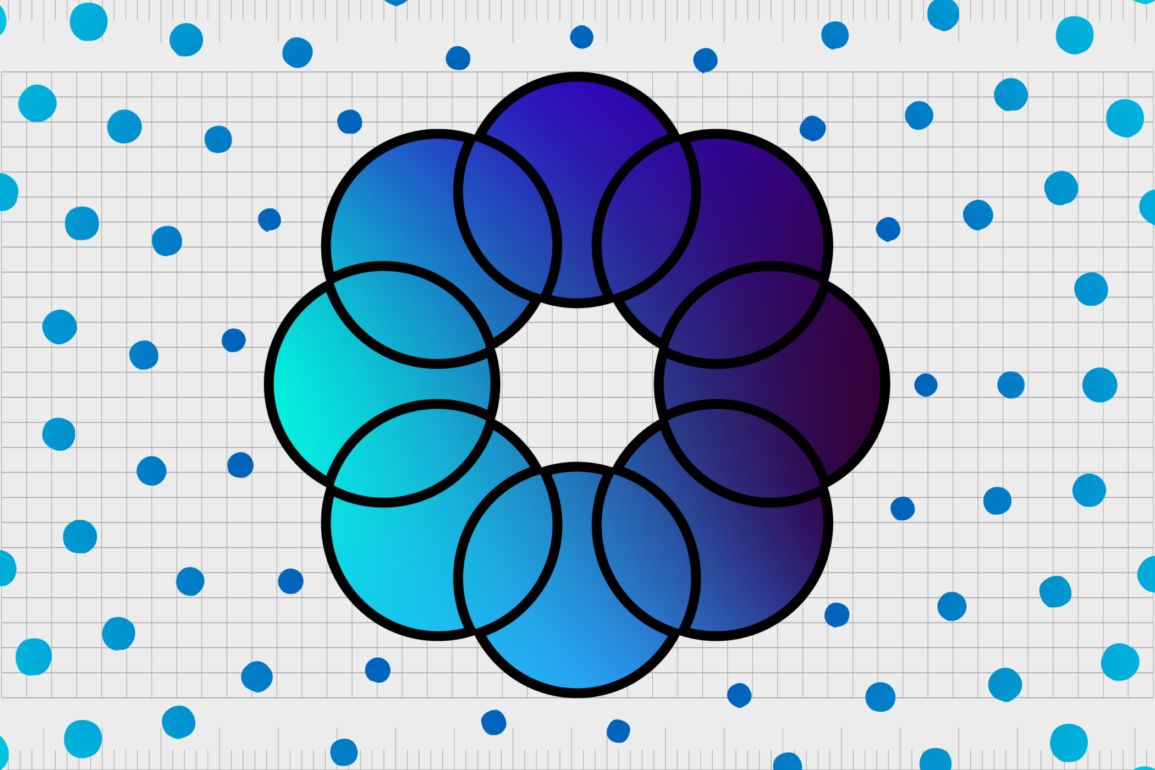
There are dozens of different shades of blue in the world today, stretching from the softest baby blue to the deepest midnight blue. This cool and relaxing shade is one of the most versatile in the world, appearing in a host of different environments, from business branding to the natural world.
According to studies dating back to the 1940s, blue is the world’s favorite color, and it’s easy to see why. Shades of blue can be calming and soothing, or rich and powerful, depending on where you land in the spectrum.
It’s also worth noting we’re often exposed to this color on a regular basis, as we constantly see the blues of the sky, as well as natural bodies of water.
While it would be difficult to name all the kinds of blue in one article, we’re going to use this opportunity to cover a host of the most popular choices.
Here’s your complete guide to different shades of blue.
Different shades of blue: An introduction
Blue is one of the coolest colors in the spectrum, often associated with ice, water, and lower temperatures. We often find blue in nature in the form of the pale blue of the daytime sky or the rich blue of a pool of deep water.
Because of the presence of this color in many consistent areas throughout the world, we often see blue as serene and calm.
Blue is often viewed as a non-threatening color, which can also appear as traditional and conservative, depending on the hue. Commonly, this shade is seen as a symbol of reliability and stability, or peace and tranquility.
Blue is secure and orderly, and in the branding world, it can often convey a sense of trustworthiness and credibility.
In color psychology, all shades, no matter how popular, have positive and negative feelings linked to them. For instance, while cool shades of blue can be calming, their coldness is also often associated with feelings of aloofness or sadness.
Often considered the least appetizing color, blue is the color used by a number of weight loss companies. According to scientists, this is likely because we don’t see a lot of blue in the food landscape (aside from blueberries).
Blue can also be inspiring. While it lowers pulse rate and body temperature, studies have shown people can be more productive in blue rooms, perhaps because the color assists with reducing feelings of stress and tension.
Colors and names of shades of blue
The different shades of blue we’re going to cover today fall into several categories. As you might already know, blue has an entire spectrum of shades starting with the lightest, palest of colors, and running all the way to the deepest and darkest colors.
Mixed correctly, colors of blue can be extremely close to either white or black. Additionally, it’s possible to create different types of blue by mixing the shade with other complementary colors. For instance, there are numerous shades of grey-blue, purple-blue, and green-blue.
Today, we’re going to cover many of the components of the blue color palette, starting with the lightest shades.
Light shades in the blue color palette
Lighter shades of blue are often considered relaxing, calming, and soft. Depending on how you define “light blue”, you might include brighter shades, like electric blue, as well as traditionally pale shades of blue, like sky blue or baby blue.
Light blue is often the most calming color on the spectrum, as well as often coming across as sincere and reliable. The depth and mystery of darker blue isn’t as significant here, so we can enjoy a cleaner, more tranquil experience from these hues.

Sky blue
Hex #87CEEB
RGB 135, 206, 235
CMYK 43, 12, 0, 8
Easily one of the most popular blue hues, sky blue is a soft and relaxing color, intended to represent the infinite possibilities of the sky. This is a color seen frequently in rooms around homes, as well as in the branding world, as a tool for conveying credibility and reliability.

Powder blue
Hex #B0E0E6
RGB 176, 224, 230
CMYK 23, 3, 0, 10
Powder blue is one of the paler shades of blue in the spectrum. This color is similar to a lot of grey-blues, as it has a colder tone to it. The color, like sky blue, is frequently associated with calmness and serenity, and it can be very relaxing, as it’s not as vibrant as other blues.

Celeste
Hex #B2FFFF
RGB 178, 255, 255
CMYK 30, 0, 0, 0
An interesting shade of light blue with an air of brightness to it, celeste is one of the more eye-catching of the light blue shades. This color is great for grabbing attention with a cool, fresh design.
This is a shade of blue more likely to be associated with refreshment than calming or relaxing emotions.

Columbia blue
Hex #D1EAF0
RGB 209, 234, 240
CMYK 13, 3, 0, 6
Similar to sky blue, but with extra grey elements, Columbia blue is a highly sophisticated shade, excellent for conveying ideas of trustworthiness and credibility. The cool and calming impact of this blue would make it an excellent choice for a company trying to offer peace of mind.
You’d be more likely to see Columbia blue in the branding world if you were creating an image for a health company or financial brand.

Beau blue
Hex #BCD4E6
RGB 188, 212, 230
CMYK 18, 8, 0, 10
Beau blue is a soft grey-blue shade similar to Columbia blue. This shade is very cool and lacks a lot of the vibrancy of a lot of colors which are usually mixed with shades of purple and green. This may be a good choice if you’re looking for a blue with simplicity.

Baby blue
Hex #89CFF0
RGB 137, 207, 240
CMYK 43, 14, 0, 6
Baby blue is a slightly more intense shade of light blue, with a level of brightness to it. This is the kind of cool and refreshing color often used in association with the birth of a baby boy.
It’s this specific kind of blue which eventually led to blue being associated with boys, and pink being more commonly associated with girls.

Baby blue eyes
Hex #A1CAF1
RGB 161, 202, 241
CMYK 33, 16, 0, 5
Baby blue eyes is a blue hue with a more natural edge to it. This color is closer to the kind of shade we’d likely see in a pair of human eyes. There are elements of grey and purple in this blue, which helps to give it an additional sense of depth and warmth.

Little boy blue
Hex #6CA0DC
RGB 108, 160, 220
CMYK 51, 27, 0, 14
Little boy blue, like baby blue, is intended as a more masculine color, combining a deeper, darker shade of blue, with white, to create a lighter hue. This color blue is something we might also associate with a slightly stormier, colder sky.
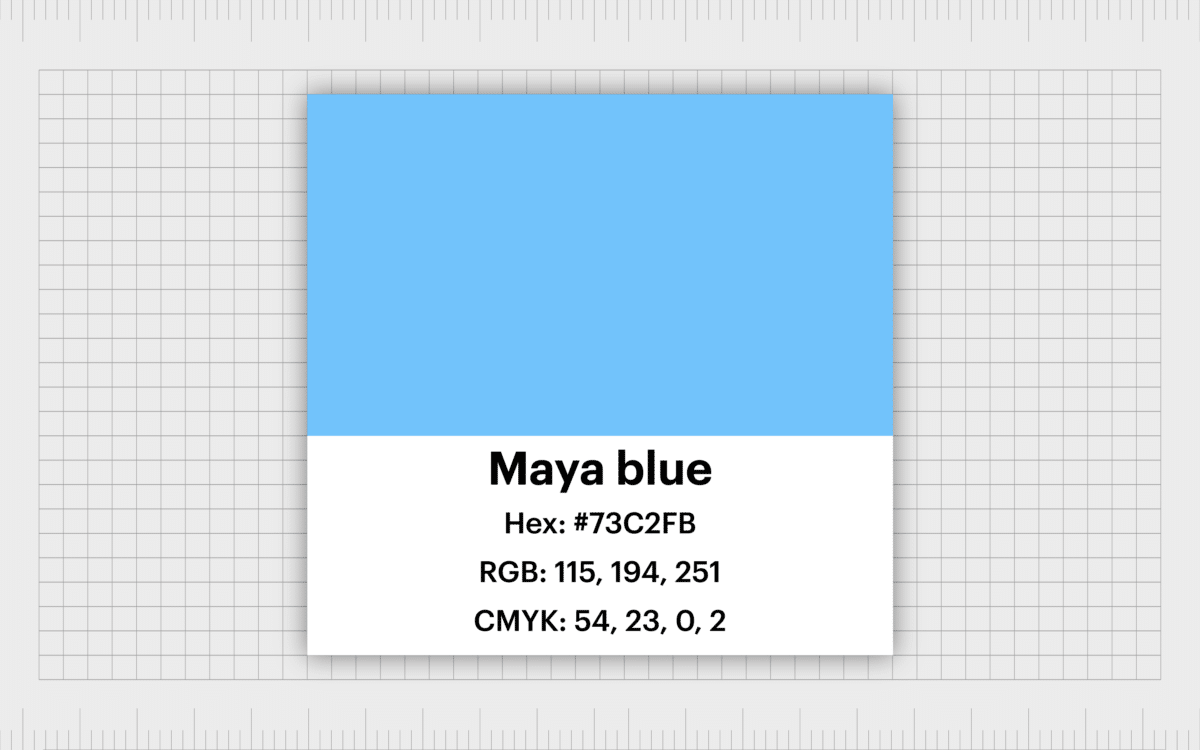
Maya blue
Hex #73C2FB
RGB 115, 194, 251
CMYK 54, 23, 0, 2
Maya blue is a much brighter shade of light blue, ideal if you want to create a sense of liveliness and warmth in a blue composition. This brighter shade is a little less likely to be associated with coldness, as it reminds us of a sky warmed by the sun.

Blue jeans
Hex #5DADEC
RGB 93, 173, 236
CMYK 61, 27, 0, 7
Blue jeans is a delightful shade of blue, closer to the kind of color you might see on a pair of modern jeans in the fashion world. This color is also fantastic for all kinds of interior design projects, as it can help to brighten up a room with the colors of the sky.

Blizzard blue
Hex #ACE5EE
RGB 172, 229, 238
CMYK 28, 4, 0, 7
With slight green and grey tones attached to it, blizzard blue is intended to be a much colder color. This hue is perfect for conveying serenity and professionalism in a business landscape, but it can also add a beautiful finish to an interior design plan.

Alice blue
Hex #F0F8FF
RGB 240, 248, 255
CMYK 6, 3, 0, 0
Easily one of the palest shades of blue on our list, Alice blue is extremely close to white, with just the slightest tint of blue included to bring the shade to life. This blue reminds us of the wispy color of clouds.
The color is likely to appear in the branding world, as well as in interior design, and product design.

Light cyan
Hex #E0FFFF
RGB 224, 255, 255
CMYK 12, 0, 0, 0
Cyan is one of the brighter blue shades on the color wheel, and one of the richest kinds of blue you can create for any composition. To create light cyan, artists include additional white in the image.
The white helps to subdue some of the liveliness of the brighter color, while still maintaining many of the eye-catching elements of cyan itself.
Different color blues: Bright blue shades
While lighter shades of blue are usually associated with extra levels of white in the mixture, or a kind of cool paleness, bright blues add a sense of vibrancy to an otherwise cold shade. These kinds of blue are more likely to be seen as fun, friendly, and refreshing.

Electric blue
Hex #0892D0
RGB 8, 146, 208
CMYK 96, 30, 0, 18
One of the most popular shades of bright blue, electric blue is light, bright, and brimming with life. The shade is much deeper and often more eye-catching than many of the common light blues mentioned above.
Sometimes, artists and companies will darken or lighten their electric blue to shade to give it additional depth.
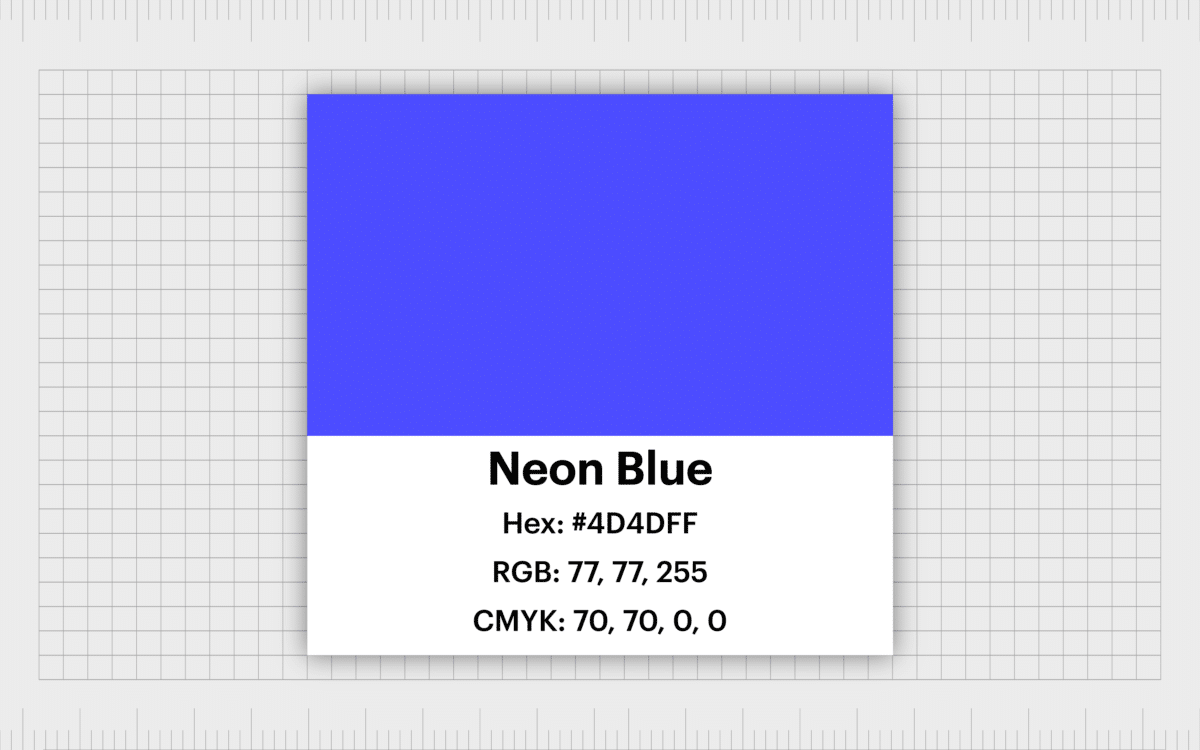
Neon blue
Hex #4D4DFF
RGB 77, 77, 255
CMYK 70, 70, 0, 0
Compared to other blue colors, neon blue is one of the brightest on this list, intended to immediately grab attention and strand out against a range of backgrounds. Neon blue is vibrant and exciting, with a significant amount of richness baked into the shade.
Many types of neon blue have a kind of purple hue to them, which provides additional warmth.

Azure blue
Hex #007FFF
RGB 0, 127, 255
CMYK 100, 50, 0, 0
Azure blue is a deeper, richer blue intended to convey one of the darkest shades of the natural sky. When the weather is sunny and the day is warm, you might notice the sky evolving into this shade of blue.
It’s a beautiful color for all kinds of compositions and it’s great for standing out with branding.

Cyan blue
Hex #00FFFF
RGB 0, 255, 255
CMYK 100, 0, 0, 0
Cyan blue is among the brightest and lightest kinds of blue on the color palette, and it’s also one of the shades you’ll find mentioned a lot in color theory. Cyan blue is a bright mixture of blue and green, commonly used to convey a sense of warmth and liveliness within an otherwise cold shade.
Cyan blue is also a common color for printer cartridges.

Dodger blue
Hex #1E90FF
RGB 30, 144, 255
CMYK 88, 44, 0, 0
Dodger blue is a bright and light shade of blue with a hint of purple hidden within the composition. This is a great color for conveying ideas of trustworthiness and stability. Bolder shades of blue are a common choice for many branding initiatives.

Vivid blue sky
Hex #00CCFF
RGB 0, 204, 255
CMYK 100, 20, 0, 0
Similar to many shades of blue, vivid blue sky is named for its close connection to one of the many colors of our natural sky. This is the kind of color you might spot above you when taking a stroll on a spring day.
It’s also a popular color for interior décor, particularly in bathrooms.

Capri blue
Hex #00BFFF
RGB 0, 191, 255
CMYK 100, 25, 0, 0
Another wonderfully bright shade, Capri blue is a very solid color, similar to something you might see in slightly deeper pools of ocean water or in ponds.
This color is engaging and refreshing, and it’s a shade you might have seen in a number of different environments, from car finishes to artwork.

Aqua blue
Hex #00FFFF
RGB 0, 255, 255
CMYK 100, 0, 0, 0
Similar to neon blue, aqua blue is a very bright color which often needs to be used somewhat sparingly in any composition. While this blue still has the bracing appeal of many shades of blue, it can be a lot more stimulating than many other softer colors.
Too much of this shade can be overwhelming, particularly in branding.
Names of shades of blue: Rich blues
The term “rich” in color composition is usually given to hues with a significant amount of pigment and depth. These colors are often closer to “truer” blues, as they feature more of the central primary color, rather than subduing it with various extra hues like white, black, green and purple.

Royal blue
Hex #4169E1
RGB 65, 105, 225
CMYK 71, 53, 0, 12
Easily among the most popular and well-recognized shades of blue, royal blue originally gained its popularity in the UK, where it was frequently associated with royalty. Royal blue is a slightly darker shade of blue, but it still has a significant brightness to it.

True blue
Hex #0073CF
RGB 0, 115, 207
CMYK 100, 44, 0, 19
Best known as the official color of the University of California, true blue is a shade placed perfectly in the middle of the blue color spectrum. Neither too dark or too light, this bright and pleasant tone is excellent for capturing attention without being too visually overwhelming.

Cerulean blue
Hex #2A52BE
RGB 42,82,190
CMYK 78, 57, 0, 25
An extremely popular pigment for artists, cerulean blue was named originally in ancient times, and continues to have a massive impact on the world today. Cerulean blue is a shade often used to convey stability and trustworthiness in branding.
It’s also an excellent color for mixing when you want to create new shades in an artwork.

Phthalo blue
Hex #000F89
RGB 0, 15, 137
CMYK 100, 89, 0, 46
Another color which appears a lot in the art world, Phthalo blue is excellent for mixing amazing shades of rich green. This color is a deep and crystalline color, ideal for adding a sense of stability and even mystery to a branding palette.
This attractive blue is darker than many of the shades on this list, but it still maintains a refreshing richness.

Persian blue
Hex #1C39BB
RGB 28,57,187
CMYK 85, 70, 0, 27
A restorative and reviving shade, Persian blue has roots extending all the way to Persia. This is one of the most common shades of blue associated with a sense of richness and luxury. The Persian blue color is extremely refined and elegant, perhaps in part due to its slight purple hue.
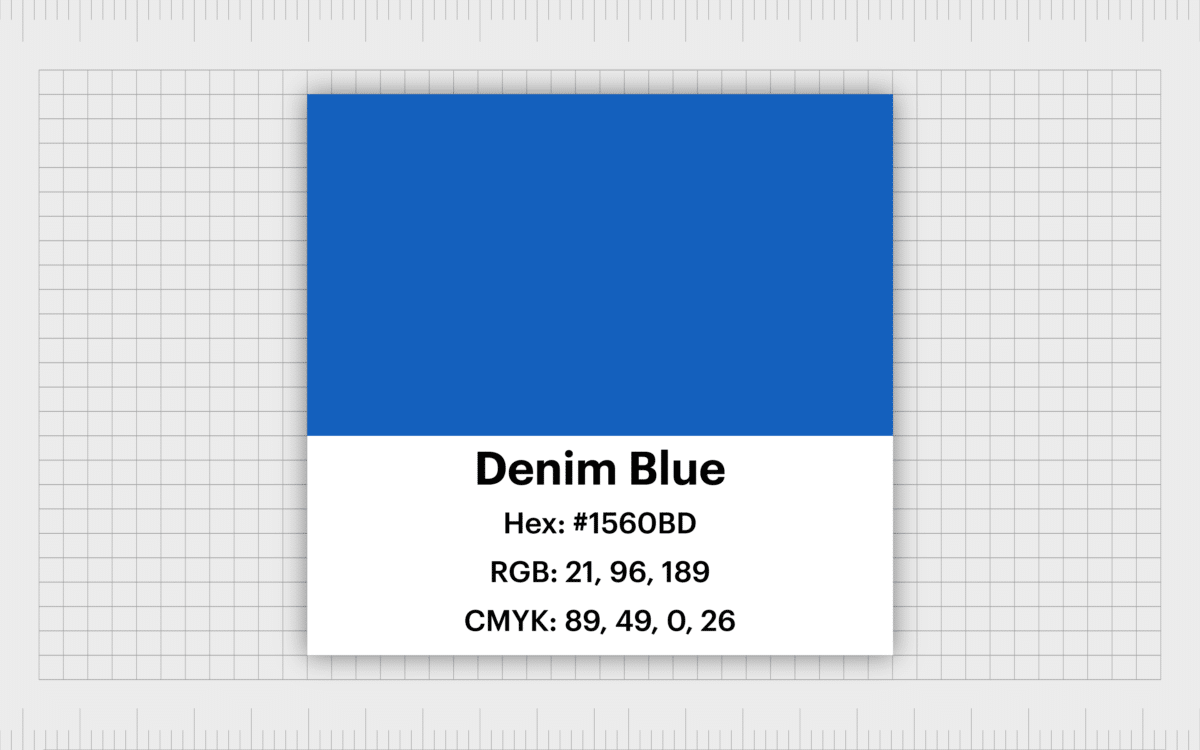
Denim blue
Hex #1560BD
RGB 21,96,189
CMYK 89, 49, 0, 26
Common in the fashion world, denim blue is the color we’d often associate with old American jeans and countless denim creations through the years.
This color is rich and cool at the same time, combining the bright energy of a deep shade of blue, with a slightly muted edge to ensure the coloring isn’t overwhelming on clothes.

Absolute zero
Hex #1F4AB8
RGB 31, 74, 184
CMYK 83, 60, 0, 28
Absolute zero is a slightly cooler shade of rich blue, with a fantastic level of depth. This is the kind of shade you might use for a branding strategy when you want to create something invigorating, without overwhelming your audience with too much brightness.

Cobalt blue
Hex #0047AB
RGB 0, 71, 171
CMYK 100, 58, 0, 33
One of the most popular hues in the blue spectrum, cobalt blue is actually created by sintering aluminum oxide and cobalt oxide. The chemical reaction creates an extremely unique shade of blue, with elements of brightness and vivacity.
In lighter hues, there are more purple elements to this blue.

Sapphire blue
Hex #0F52BA
RGB 15, 82, 186
CMYK 92, 56, 0, 27
Another bright and rich blue taken from the natural world, sapphire blue is the color often associated with the precious gem, sapphires.
There are various types of blue belonging to the sapphire collection, including softer shades like medium sapphire, and dark sapphire, which is often associate with luxury, mystery, and sophistication.
Different color blues: Dark blue shades
Darker blue shades in the modern color spectrum are usually associated with sophistication and luxury, as more pigment in ancient times often meant you had more money to spend.
Because of their connection to things like the night sky, dark blue colors can also be linked to concepts like mystery and uncertainty.

Navy blue
Hex #000080
RGB 0, 0, 128
CMYK 100, 100, 0, 50
Probably one of the better-known kinds of blue in the dark blue collection, navy blue is a deep shade compared to most blues. It’s used in many countries around the world to create all kinds of fashion items, as well as products and packaging.
Navy blue is often considered a more sophisticated color, making it good for serious occasions.

Midnight blue
Hex #003366
RGB 0, 51, 102
CMYK 100, 50, 0, 60
Mysterious and elegant at the same time, midnight blue can spark a range of emotions. Though it’s commonly linked to concepts like tranquility, due to its connection with the night sky, it can also be seen as deeply luxurious and sophisticated.
This could be an excellent shade for a company trying to demonstrate a depth of knowledge.

Prussian blue
Hex #003153
RGB 0, 49, 83
CMYK 100, 41, 0, 67
One of the most popular kinds of blue for those in search of deep, dark tones, Prussian blue is a cool color with hints of green and black tones.
Interestingly, the name “Prussian blue” actually comes from the Prussian state in Germany. The region was known for using a deep blue color for the uniforms of their Prussian army in the 17th and 18th century.

YInMn blue
Hex #2E5090
RGB 46, 80, 144
CMYK 68, 44, 0, 44
A slightly unusual shade of blue common among darker shades is YInMn blue. According to historical archives, the color was discovered following an accident in a lab.
In contrast to different color blues, this hue is one of the colder options on our list, with very little of the vibrancy seen in other hues. Its sophisticated vibe could make it ideal for branding in a range of industries.

Oxford blue
Hex #002147
RGB 0,33,71
CMYK 100,54, 0, 72
Another of the most popular dark blue shades on our list, Oxford blue is definitely one of the most eye-catching shades available. This color is often considered trendy and fashionable, perfect for the apparel industry.
It’s also a color likely to be common to use if you’re familiar with Oxford University, one of the most prestigious universities around.

Ultramarine blue
Hex #120A8F
RGB 18, 10, 143
CMYK 87, 93, 0, 44
One of the richer dark blue shades on our list, ultramarine blue is a very popular hue, combining some of the brightness of electric blue with hints of black.
This all-encompassing shade is ideal for companies hoping to convey a sense of luxury and stability. It could also be a fantastic color for a range of products, including cars.

Resolution blue
Hex #002387
RGB 0, 35, 135
CMYK 100, 74, 0, 47
Sophisticated and elegant, Resolution blue is brimming with a sense of deep heritage. This shade has a mature element to it which could make it a good pick for a branding strategy for a company hoping to portray a worldly and cultured image.
The color is also excellent for all kinds of interior design and product options, as it’s still bright enough to catch the eye.

Royal blue dark
Hex #002D72
RGB 0, 45, 114
CMYK 100, 61, 0, 55
Royal blue is one of the more popular shades in the blue color spectrum, and it’s also highly versatile. Adding additional purple and black can create a deeper shade, in the form of royal blue dark.
This shade is practical and eye-catching, great for companies or individuals who like the impact of royal blue but want something more mature.

Yale blue
Hex #00356B
RGB 0, 53, 107
CMYK 100, 50, 0, 58
Many of the most prestigious schools around the world use shades of blue in their coloring to demonstrate authority and influence. Yale blue is one such example. This darker shade of blue has an almost turquoise element to it, indicating a slight spark of creativity.

Navy blue
Hex #000080
RGB 0, 0, 128
CMYK 100, 100, 0, 50
Easily one of the better-known kinds of blue belonging to the darker spectrum, navy blue got its name from the dark blue uniforms worn by officers in the Royal Navy throughout the 1700s, this color was also eventually adopted by countless other naval groups around the world.
Different blues: Green blue hues
As mentioned above, one of the factors which makes the blue color palette so expansive, is the ability to mix the shade with a range of other colors to get different results. One of the most common kinds of blue created by mixing colors are green/blue hues like turquoise and teal.
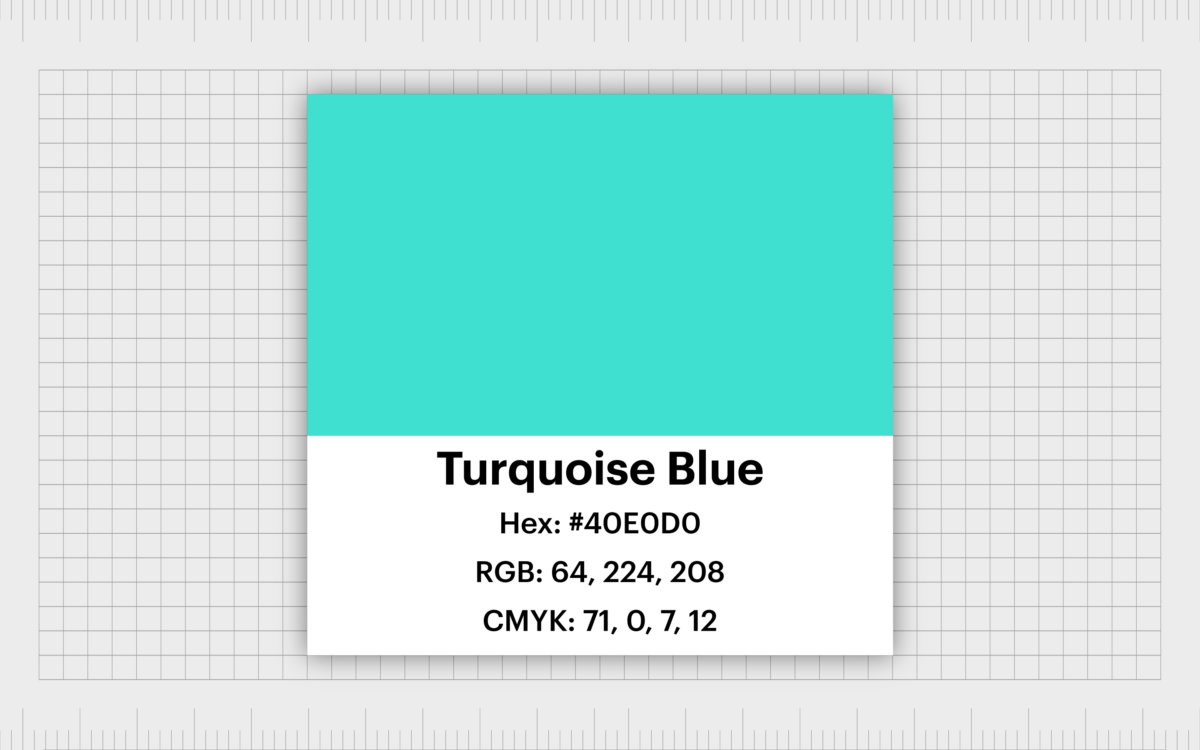
Turquoise
Hex #40E0D0
RGB 64, 224, 208
CMYK 71, 0, 7, 12
Turquoise is the color of a gemstone first discovered within ancient Egyptian tombs. To those familiar with the stone, it can hold great significance and is commonly associated with a range of superstitions.
This color is common in jewelry today, as well as a host of fashion pieces.

Tiffany blue
Hex #0ABAB5
RGB 10, 186, 181
CMYK 95, 0, 3, 27
One of the few shades of blue associated with a specific brand, Tiffany blue is the colloquial name for the light medium hue associated with Tiffany and Co., a New York jewelry company.
The color was initially used on the cover of the Tiffany’s blue book and appeared in the packaging for the brand to this day.

Blue Munsell
Hex #0093AF
RGB 0, 147, 175
CMYK 100, 16, 0, 31
Blue Munsell belongs to the Munsell color system, a color space which specifies colors based on guidelines divided into five principal hues, including red, yellow, blue, green, and purple.
The Blue Munsell shade is somewhere between blue and green, giving it a mysterious, creative vibe.
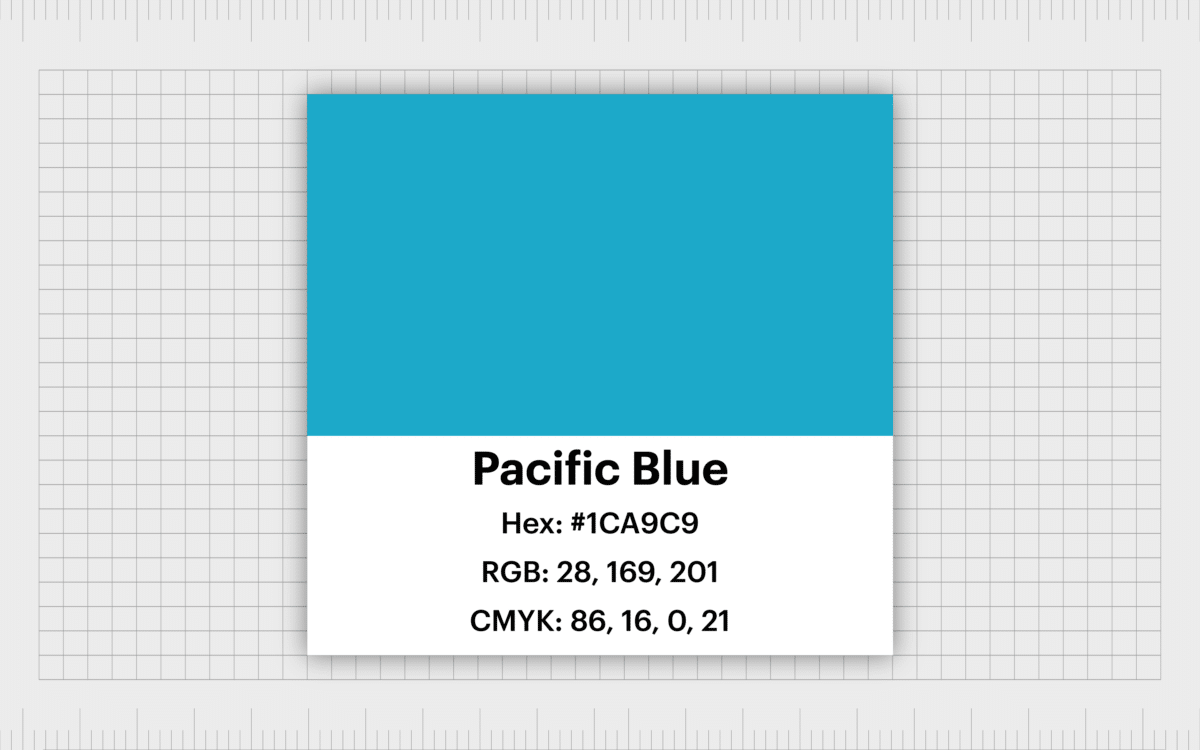
Pacific Blue
Hex #1CA9C9
RGB 28, 169, 201
CMYK 86, 16, 0, 21
Look deep into the ocean at specific locations in the world and notice it’s not entirely blue. There are elements of green mixed into the water. This is something artists can capture with shades like Pacific blue, which combine light blue shades with slightly green elements.

Blue Green
Hex #0D98BA
RGB 13, 152, 186
CMYK 93, 18, 0, 27
Probably the most common and well-known blue/green color, blue-green refers to the shade on the blue spectrum located mid-way between green and blue.
This color appears a lot in the fashion world, but it’s also frequently used in branding to convey a mixture of blue and green ideals, like nature, creativity, and reliability.

Celadon blue
Hex #007BA7
RGB 0, 123, 167
CMYK 100, 26, 0, 35
Celadon blue is the name of a pigment discovered in the eighteenth century. Eventually, the name was updated to “cerulean blue” in some parts of the world. The cerulean blue shade is commonly considered a “quaternary color” in the RYB color spectrum.

Cadet blue
Hex #4F97A3
RGB 79, 151, 1 63
CMYK 52, 7, 0, 36
Featuring a mixture of shades including blue, green, and grey, cadet blue was initially discovered in the UK, during the late 1980s. The shade was actually formulated as one of the X11 colors in 1987, which eventually became part of the X11 web colors.

Teal
Hex #008080
RGB 0, 128, 12, 8
CMYK 100, 0, 0, 50
An interesting mixture of cyan and green, teal is an eye-catching shade ideal for a range of design and branding compositions. Interestingly, the name actually comes from a bird (the Eurasian teal) which has a colored stripe on its head.
There are also variations of teal, like “teal blue” which add slightly more blue to the mix than green.

Bright turquoise
Hex #08E8DE
RGB 8, 232, 222
CMYK 97, 0, 4, 9
As a relatively versatile shade in the blue spectrum, turquoise comes in a variety of different temperatures and styles, including a much brighter variation (bright turquoise). This color comes from a more brilliant blue shade mixed with green.

Robin’s egg
Hex #00D8D8
RGB 0, 216, 216
CMYK 100, 0, 0, 15
Perhaps unsurprisingly, the name for robin’s egg blue comes from the natural shade of the robin’s egg, which is usually a blue-ish green color. According to science, the color of a robin’s egg is unique because of the biliverdin pigment in the eggshells.
Colors of blue with purple shades
Similar to how mixing green and blue can create a wide range of new colors, combining blue and purples can also enhance your palette too. Some shades of blue are so close to purple it’s difficult to tell where one hue ends and the other begins.

Indigo blue
Hex #4B0082
RGB 75, 0, 130
CMYK 42, 100, 0, 49
Indigo blue is an extremely rich shade of purple/blue, with many warm red tones. This color is frequently used to depict sophistication and luxury in branding, but it’s also common in the decorative world.
Indigo blue can be a rich and powerful shade as a statement wall or focal point in a room.

Lavender blue
Hex #CCCCFF
RGB 204, 204, 255
CMYK 20, 20, 0, 0
Named after the lavender plants that delight people around the world with their soothing scend, lavender blue is a much lighter shade of purple/blue. This color is created by mixing soft shades of blue with lots of white and either a hint of red, or purple.

Slate blue
Hex #6A5ACD
RGB 106, 90, 205
CMYK 48, 56, 0, 20
While the term “slate blue” might draw more grey-ish tones to mind, the color is actually a lot more purple in hue than you might think. This color combines cooler hues of blue with reds and purples to create an eye-catching and friendly shade.

Picotee blue
Hex #2E2787
RGB 46, 39, 135
CMYK 66, 71, 0, 47
Like many shades in our color spectrum, the name for Picotee blue comes from the natural world, and the beautiful Picotee blue flower, otherwise known as “morning glory”. This stunning flower combines rich and bold shades of blue with softer streaks of purple.

Violet blue
Hex #324AB2
RGB 50, 74, 178
CMYK 72, 58, 0, 30
Another blue/purple shade taken from the natural world; violet-blue is the name given to the color created when mixing violet with a slightly heavier shade of blue. Although the blue elements are more overwhelming in this pigment, it’s still possible to see the purple undertone.

Ocean blue
Hex #3C41CD
RGB 238, 59, 52
CMYK 71, 68, 0, 20
The name for “ocean blue” was chosen to represent the color we see in deeper bodies of water, when darker blues are mixed with other shades like reds and greens. The color of ocean blue is extremely rich, making it ideal for a wide range of painting and artistic endeavors.

Cornflower blue
Hex #6495ED
RGB 100, 149, 237
CMYK 58, 37, 0 ,7
A light blue shade with just the slightest hint of purple, cornflower blue is common in many forms of interior decoration, as well as product design.
There’s also a good chance you’ll see shades similar to this in a lot of branding strategies, as the color is non-combative, and excellent for conveying a sense of reliability and trust.
Common kinds of blue: Grey blue shades
Finally, the last section we’ll be looking at on our journey through the various different shades of blue, is grey/blue shades. When hues from the blue color palette are mixed with elements of black and white, they can create pale or deep new shades.
These colors are often much cooler than many alternative blues and can have a more sophisticated impact.

Blue gray
Hex #6699CC
RGB 102, 153, 204
CMYK 50, 25, 0, 20
Blue-gray, or blue-grey, is a medium blue color mixed with elements of grey. The hue is quite dull, making it less aggressive for the eyes, and quite relaxing to look at. While this color is quite cold, it can also appear very mature and professional, ideal for various kinds of branding.
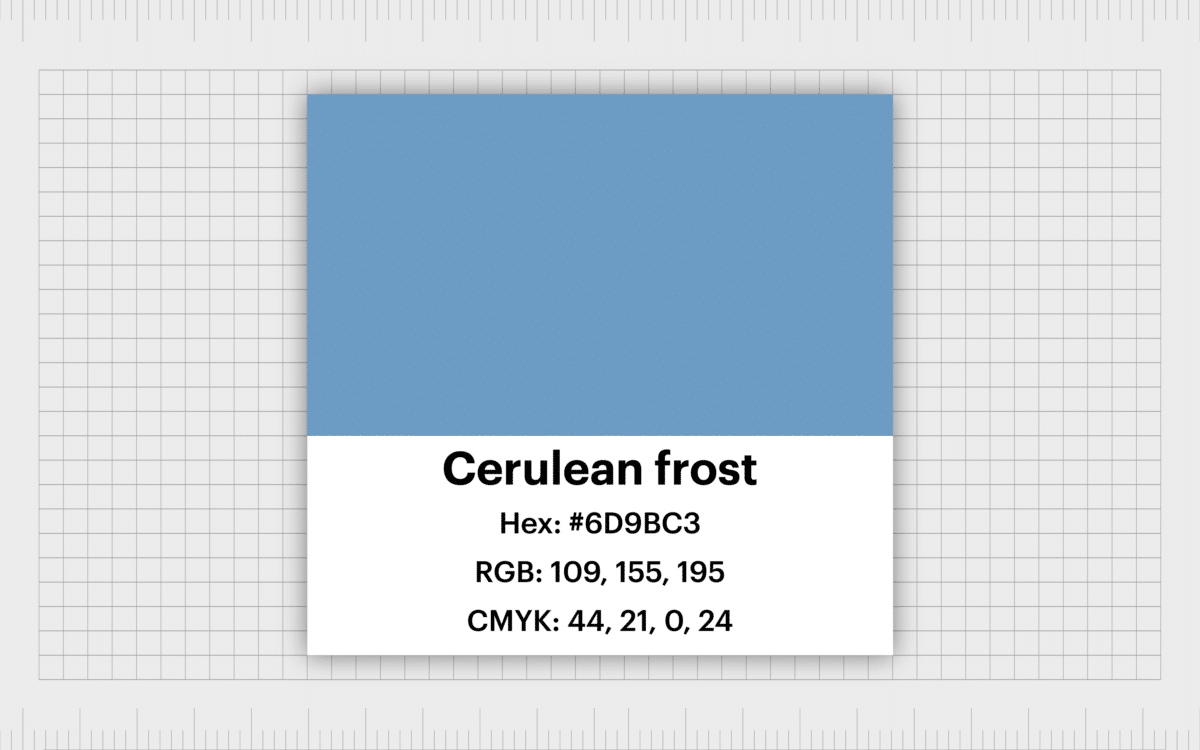
Cerulean frost
Hex #6D9BC3
RGB 109, 155, 195
CMYK 44, 21, 0, 24
The color “cerulean frost” comes from mixing the richer, bright hues of cerulean, with elements of grey and white. This significantly dulls the base cerulean while reducing its visual impact.
Cerulean frost is a good background color or “neutral” shade, because it mixes well with a range of other colors.

Shadow blue
Hex #7285A5
RGB 114, 133, 165
CMYK 31, 19, 0, 35
Somewhat more mysterious than some of the other blues we’ve covered so far, shadow blue is an extremely grey version of blue, with only the slightest hints of blue hidden within the pigment.
This is an excellent color for a company looking for an extremely sophisticated, mature, and subdued color palette, perhaps in the legal industry.
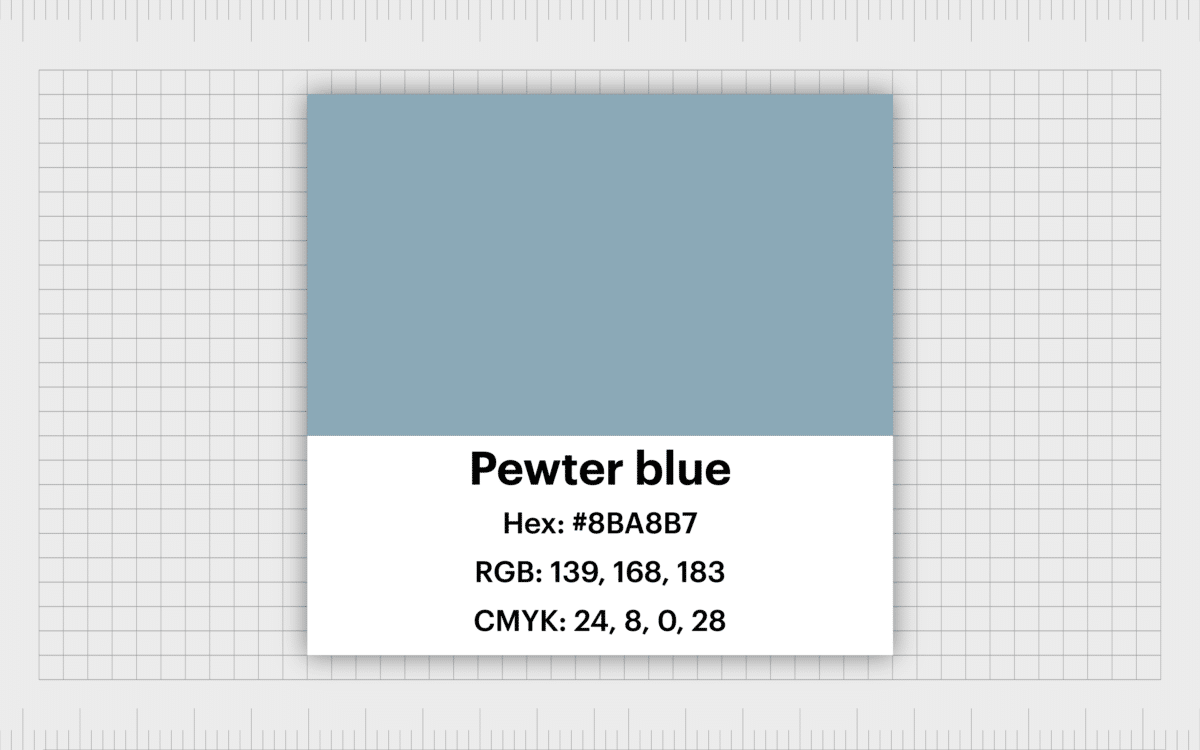
Pewter blue
Hex #8BA8B7
RGB 139, 168, 183
CMYK 24, 8, 0, 28
Modern and neutral, pewter blue is an excellent shade to mix with other colors if you’re trying to create contrast. This color combines a lot of the prestige and authority associated with the color grey with the reliability and trustworthiness of blue.

Air superiority blue
Hex #72A0C1
RGB 114, 160, 193
CMYK 41, 17, 0, 24
The name for this shade of blue comes from the light blue uniforms issued to the newly formed Royal British Air Force during the 1920s. The color would later influence the design of various uniforms for other air force groups around the world.

Steel blue
Hex #4682B4
RGB 70, 130, 180
CMYK 61, 28, 0, 29
One of the most popular shades of grey/blue available today, steel blue appears commonly in various design strategies, as well as branding campaigns. This color has much of the brightness of a bolder shade of blue, mixed with a significant amount of grey, to highlight sophistication.

Space cadet
Hex #1D2951
RGB 29, 41, 8, 1
CMYK 64, 49, 0, 68
Created for the modern era of space travel, space cadet is a shade of blue conceived as the potential uniform colors for people responsible for exploring space. The color combines a much darker shade of blue, often associated with mystery and exploration, with deep shades of grey.
Expanding your blue color palette
It’s fair to say there are plenty of different shades of blue to choose from in today’s versatile world. Whether you’re looking for the perfect shade for your new bedroom, or you want a base color for your branding strategy, blue could be the perfect color for you.
Blue is an extremely diverse color, brimming with different options to choose from. While there are only a handful of blues in the natural world, from blue flowers to the sea, sky, and blue eyes, blue continues to be the most popular shade for the majority of the world.
Today, the various blues mentioned above can serve a wide range of purposes, from helping to identify your business as one your customers can trust to forming the foundation for a beautiful work of art.
Fabrik: A branding agency for our times.
Now read these:
—Exploring the colors of the rainbow





